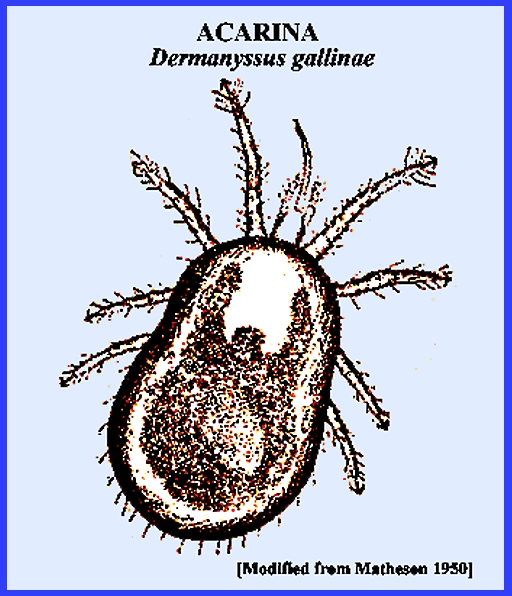File: <parasitoidea.htm> <Medical
Index> <General Index> Site Description <Navigate to Home>
|
Acarina PARASITOIDEA (Bird, Reptile &
Mammal mite parasites) (Contact) Please CLICK on
underlined links to view:
A chicken
mite, Dermanyssus gallinae (L.) is a bloodsucker that
usually feeds at night when the birds are roosting. The mites engorge rapidly and depart from their hosts in
daytime when they hide in surrounding crevices of a structure. Eggs are laid in the trash and they hatch
in 3-4 days. The larvae and nymphs
require 10 days to two weeks for development. Humans working in the vicinity are attacked, which may result
in a severe dermatitis. This species
also serves as a reservoir for the Saint Louis Encephalitis
virus in chickens. If a house
mosquito (Culex pipiens) feeds on
chickens and then on humans the encephalitis can be transmitted. The mosquito may also serve as a reservoir
for Eastern Equine Encephalomyelitis. An invaded
mite from Egypt, Dermanyssus sanguineus Hirst is parasitic on mice
and rats. It became established in
eastern North america and was found to transmit Rickettsial pox in New York State. There are two dorsal shields on the
thorax, which distinguish it from D. gallinae. Another
invaded mite species from Egypt, Liponyssus bacoti, is primarily a parasite of rats,
but it also attacks humans. The mite
feeds only on blood. Nymphs and
adults drop from their hosts after a blood meal and will invade other animals
nearby. The life cycle is short, eggs
hatching in about 4 days and adults developed 12 days later. Experiments have shown that this species
is capable of transmitting Rickettsial pox
(Rickettsia akari). CONTROL Elimination of the rats and mites
that may harbor the diseases is the preferred control method. Available acaricides applied to the
interior of heavily-infested structures is also advisable. = = = = = = = = = = = = = = = = = = = = Key References: <medvet.ref.htm> [Additional references may be found at:
MELVYL Library] Banks, Nathan. 1915.
The Acarina or Mites: A Review of the Group for the Use
of Economic Entomologists. Report No.
108, Washington D.C. Hallan, Joel.
2010. Parasitidae Species
Listing. Biology
Catalog, Texas A. & M. Univ. Matheson, R. 1950. Medical Entomology. Comstock Publ. Co, Inc. 610 p. O'Conner, B., B. Pavel & B. Klmiov. 2004. Bee Mites: Acari: Parasitiformes. Division of Insects, Univ. of Michigan
Museum of Zool. Service, M. 2008.
Medical Entomology For Students.
Cambridge Univ. Press. 289 p. Zhi-Quiang, Zhang. 2003.
Other Beneficial Mites: Mites
of greenhouses. Wallingford, Oxon,
Cambridge, MA. |
